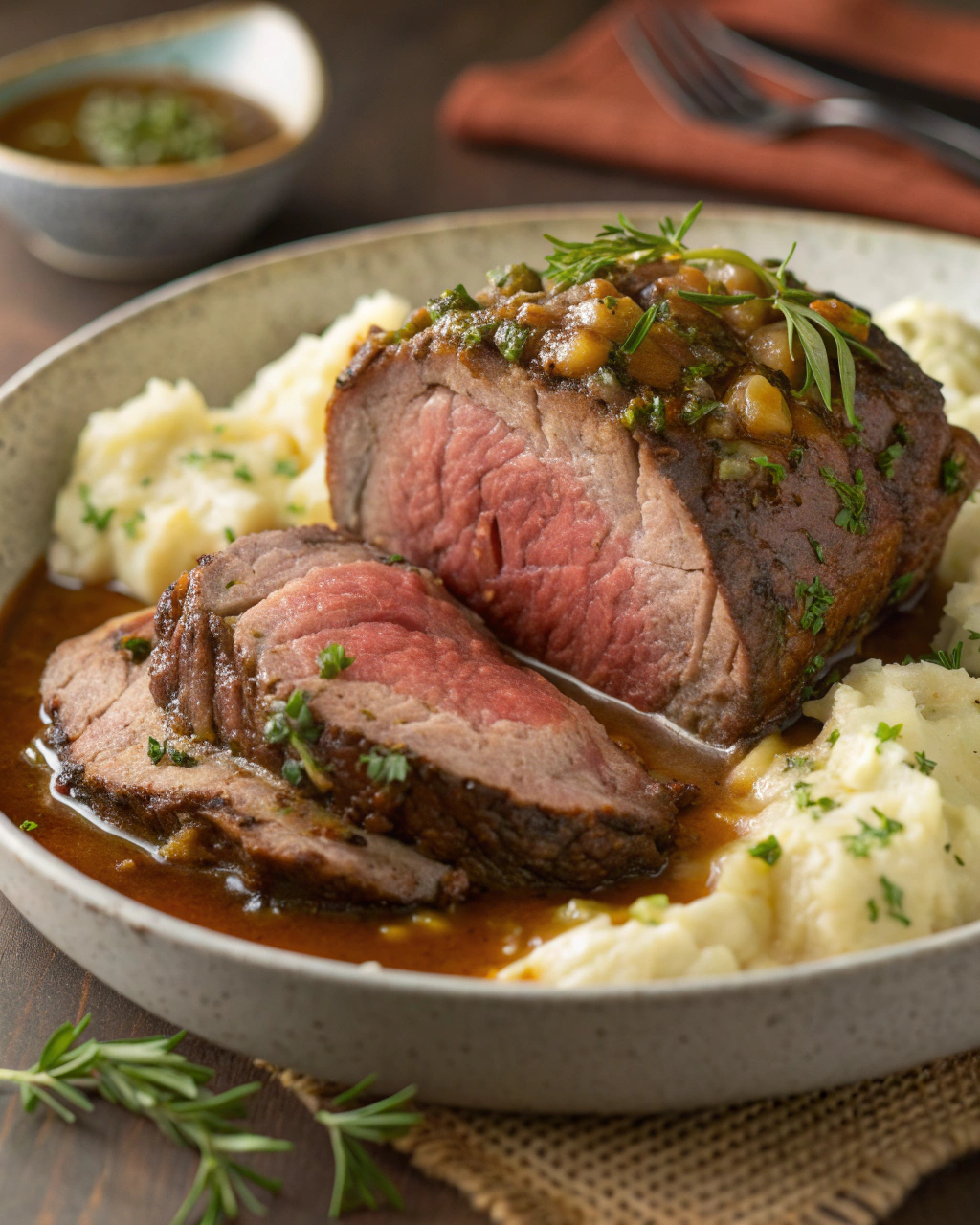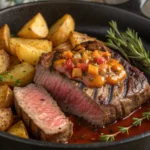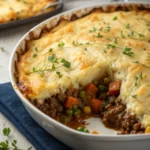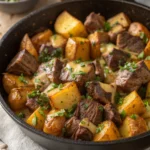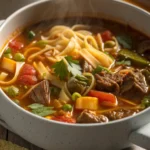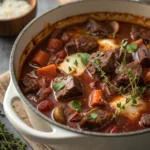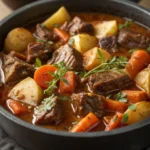When I was a kid, the whole house would smell like garlic and rosemary on Sundays — my dad would pull a big beef roast from the oven and everyone would migrate into the kitchen like moths to a lamp. I still remember the crackle when he sliced into it and the steam, smelling like warm earth and butter, rising up to fog my glasses. That memory became my shortcut to comfort, and this Garlic Herb Beef Roast with Mashed Potatoes is my grown-up version: simple, hearty, and reliably cozy. It crisps on the outside, stays juicy inside, and pairs with buttery mashed potatoes that soak up every last bit of gravy. Trust me, this is the roast you’ll make when you want everyone to come running.
Quick Facts
- Yield: Serves 4–6
- Prep Time: 20 minutes
- Cook Time: 1 hour 15 minutes (roast time depends on size and desired doneness)
- Total Time: 1 hour 35 minutes
Why This Recipe is Awesome
This roast hits that golden-brown, garlicky-crust high note while keeping the center tender and juicy — the kind of dinner that makes the whole house smell like an embrace. It’s forgiving, uses pantry-friendly herbs and garlic, and the mashed potatoes soak up the pan juices like a dream. It’s so easy even your oven can’t mess it up. Plus, leftovers heat beautifully and turn into epic sandwiches the next day.
Ingredients
For the Main Dish:
- 3–3.5 lb beef chuck roast (or boneless rump roast)
- 2 tbsp olive oil
- 4 cloves garlic, minced (about 2 tbsp)
- 1 tbsp fresh rosemary, finely chopped (or 1 tsp dried)
- 1 tbsp fresh thyme, chopped (or 1 tsp dried)
- 2 tsp kosher salt
- 1 tsp black pepper, freshly cracked
- 1 tbsp Dijon mustard
- 1 cup beef broth (low-sodium)
- 2 tbsp unsalted butter, sliced into pats
- 1 large onion, thickly sliced
- 2 carrots, cut into large chunks
For the Mashed Potatoes:
- 2 lb russet potatoes, peeled and cut into 1–2″ chunks
- 4 tbsp unsalted butter
- 1/2 cup whole milk (or half-and-half for richer mash)
- Salt & pepper to taste
- Chives or parsley, chopped, for garnish (optional)
How I Make It
Step 1:
I start by preheating the oven to 425°F. While it warms, I pat the beef roast dry with paper towels (this helps the crust). I rub the roast all over with olive oil, then mix the minced garlic, rosemary, thyme, Dijon, salt, and pepper in a small bowl and smear it onto every surface. You should smell that garlic and herbs — bright and tempting.
Step 2:
I heat a large oven-safe skillet over medium-high heat until it sizzles, then sear the roast on all sides for about 2–3 minutes per side until it gets a deep, caramelized color. That searing sound is flavor being made. I arrange the onion and carrots under the roast like a cozy vegetable bed, pour in 1 cup beef broth, and lay a couple of butter pats on top.
Step 3:
I roast at 425°F for 15 minutes to jump-start a crispy exterior, then lower the oven to 325°F and continue roasting for about 45–60 minutes depending on your desired doneness. For medium-rare aim for about 125–130°F internal, medium around 135°F. I use an instant-read thermometer and stick it into the thickest part — that tells the story better than time alone.
Step 4:
When the roast reaches the temp you want, I remove it to a cutting board and tent it loosely with foil for 10–15 minutes to rest. Resting lets the juices redistribute so slices stay juicy instead of running all over the board. Meanwhile, I skim fat from the pan juices and simmer them on the stove for a few minutes to concentrate the flavor into a quick gravy.
Step 5:
I mash the cooked russet potatoes with butter and warm milk, seasoning with salt and pepper. I slice the roast against the grain into thick pieces, spoon the pan jus over everything, and sprinkle chopped chives. The roast should have a dark, glistening crust and a tender, rosy interior that practically melts on the tongue.
Pro Tips
- Use an instant-read thermometer—don’t guess. For medium, pull at 135°F and let carryover heat bring it up a few degrees.
- Dry the roast thoroughly before seasoning for the best crust. Wet meat steams and won’t crisp.
- If your roast is large, sear then roast uncovered; cover only if the exterior gets too dark before the center cooks.
- Make mashed potatoes extra silky by warming the milk first and using a potato ricer or masher—not a blender (it gets gluey).
Common Mistakes to Avoid
- Skipping preheating: Classic rookie move. It changes texture and bake time.
- Overmixing: Leads to dense or chewy results. Mix until just combined.
- Guessing cook time: Always use visual cues or a timer, not just vibes.
- Overcrowding pans: Give your food some breathing room to crisp properly.
Alternatives & Substitutions
- Swap chuck roast for a sirloin tip or top round if you prefer leaner meat; the texture changes slightly but the flavor stays hearty.
- Use olive oil in place of butter for a dairy-free option; you’ll miss some buttery richness but gain a lighter finish.
- Substitute Greek yogurt mixed with a little milk for some of the milk in the mashed potatoes to reduce fat while keeping creaminess.
- For gluten-free, ensure your beef broth is labeled gluten-free; the rest of the recipe already fits GF needs.
Variations & Tips
- Add a spicy twist: mix 1 tsp smoked paprika and 1/2 tsp cayenne into the herb rub.
- Kid-friendly version: skip Dijon and use a touch of honey in the rub for a sweet glaze.
- Herb swap: use sage and oregano instead of rosemary/thyme for a different herbal profile.
- Make it weekend-slow-roast: after searing, braise at 300°F for 2–2.5 hours for an ultra-tender pull-apart finish.
- Creative twist: top mashed potatoes with roasted garlic and parmesan for an extra savory mash.
FAQ (Frequently Asked Questions)
- Can I make this ahead of time?
- Yes! Roast the beef and cool completely. Refrigerate in an airtight container for up to 3 days. Reheat gently at 300°F with a splash of beef broth covered for about 20–30 minutes to keep it moist.
- Can I double the recipe?
- Sure thing. Use a larger pan and give roasts space so heat circulates. Roast times grow slightly with size; use a thermometer and expect an extra 15–30 minutes for very large cuts.
- Can I substitute butter with oil?
- Technically yes, but you’ll miss that buttery magic. Use ¾ the amount of oil.
- How do I know it’s done?
- Look for a deep, browned crust and check the internal temperature: 125–130°F for medium-rare, 135°F for medium. The roast should feel springy and slice without tugging.
- What if I don’t have ingredient X?
- Out of rosemary? Use thyme or oregano. No Dijon? Stir in a little mustard powder with olive oil. Simple pantry swaps keep you cooking without a store run.
How I Like to Serve It
I plate thick slices atop a bed of fluffy mashed potatoes, spoon hot pan jus over the meat, and scatter bright parsley. I serve this for a cozy Sunday supper, a small holiday dinner, or a celebratory weeknight when I want everyone to linger at the table. Pair it with roasted green beans, a crisp salad, and a full-bodied red wine or a dark beer for colder months.
Notes
- Store leftovers in the fridge for up to 3 days. Reheat gently with a splash of broth to prevent drying.
- Safe cooking temp for whole beef cuts is at least 145°F per USDA; many cooks prefer slightly lower temps for tenderness—use a thermometer and your taste.
Final Thoughts
Closing: Now go impress someone — or just yourself — with your homemade masterpiece!

Hi, I’m Lina, the creator of Lina Easy Recipes.Cooking has always been my passion, and I love sharing simple, homemade dishes that anyone can prepare.
Love What You See?
Join me on Pinterest and Facebook for daily cooking inspiration, new recipe ideas, and behind-the-scenes kitchen stories. Let’s cook something wonderful together!

